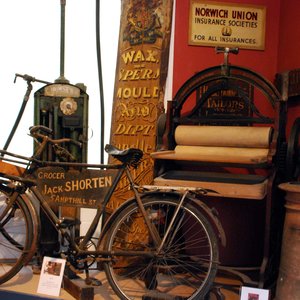The Museum of Norwich at the Bridewell
The great medieval city of Norwich offers such a wealth of heritage that it is easy to overlook the variety of industrial buildings from all periods and particularly the nineteenth century that lie within the city centre.
The industrial economy of Norwich was built on the diverse mixture of textiles, shoe manufacture, food production and pharmaceuticals. Textiles were an important medieval industry in East Anglia employing thousands of outworkers to spin the yarn for the Norwich weavers. As late as 1800, there were still as many as 100,000 outworkers spinning yarn for Norwich cloth makers. Many families owed their success to trading in cloth including the Harvey´s and Ives whose names are immortalised in the inscriptions in St Clement´s Church, Colegate.
Historically, the most important regional centre of the textile industry, Norwich was badly hit by the expansion of powered looms in the north and west of England. Some textile mills were constructed in Norwich to compete with their rivals but by 1845 there were still only 428 power looms in Norfolk as a whole to compete with 31,000 in Yorkshire. A survival of this period is the iconic St James Mill which still graces the Norwich the riverside landscape in the centre of Norwich. By 1870, the principal industry of Norwich had become leatherworking and the late Victorian period saw the construction of the mammoth Norvic Shoe Factory and others.
Breweries too expanded with the growing factory population and Bullard´s Anchor Brewery and the office block at Stewarts & Patteson´s Pockthorpe Brewery can still be admired, though much important industrial heritage has been lost. Casualties include the famous Rowntrees Chocolate factory and redevelopment is planned for the famous Coleman´s Mustard factory at Carrow, paid for (according to legend) by the ´mustard left on the plate´. The pharmaceutical industry in Norwich, too, has a pedigree dating to the eighteenth century.
Other sites to visit in Norwich include former textile factories, brush works and vinegar works together with important civil engineering structures such as Coslany Bridge. Gybsons Well is an fascinating though neglected sixteenth century water supply monument and adjoining the Norman cathedral there is a former monastic brew house dating from the medieval period.
The Bridewell Museum, hosting an outstanding collection of industrial and social memories, is itself housed in a former shoe factory and one-time prison. The building encapsulates the contradictions of this medieval and later industrial city. Make a special visit to the huge Civic Hall, built during the 1930´s in the Swedish Style. Incorporated in the entrance doors are superb pewter crests representing the industries of Norwich. A wonderful discovery not to be missed!

The Museum of Norwich at the Bridewell
Bridewell Alley
NR2 1AQ Norwich
Norfolk
East of England
United Kingdom
+44 (0) 1603 - 629127
Homepage

